Do it by yourself. Answers may vary. Fill in the blanks by considering the drinking capacity of the animals. Small animals can drink less glasses while big animals can drink more glasses. A sample answer is: Everyone finds the drink very tasty but some small guests like rats, cats cannot finish a full glass. But the deer is able to finish his glass. Some others like elephants, giraffes, deer, camels ask for more than one glass.
NCERT Solutions For Class 3 Maths Chapter 11 - Jugs and Mugs
Jugs and Mugs deals with the concept of measuring volume through nonstandard units. This chapter have exercises on measuring and comparing volumes by jugs, mugs, containers. The solutions for Math-Magic Chapter-11 have been created and verified by our experienced subject matter experts, according to the CBSE syllabus and guidelines of NCERT. For practice, our subject matter experts have created very interactive, activity-based, and Image-based worksheets on these topics to enhance learning. The NCERT Solutions of Math-Magic for Class-3, Chapter-11: Jugs and Mugs in PDF format can be downloaded for free Click here.
Download PDF For NCERT Solutions for Maths Jugs and Mugs
The NCERT Solutions For Class 3 Maths Chapter 11 - Jugs and Mugs are tailored to help the students master the concepts that are key to success in their classrooms. The solutions given in the PDF are developed by experts and correlate with the CBSE syllabus of 2025-2026. These solutions provide thorough explanations with a step-by-step approach to solving problems. Students can easily get a hold of the subject and learn the basics with a deeper understanding. Additionally, they can practice better, be confident, and perform well in their examinations with the support of this PDF.
Download PDF
Access Answers to NCERT Solutions For Class 3 Maths Chapter 11 - Jugs and Mugs
Students can access the NCERT Solutions For Class 3 Maths Chapter 11 - Jugs and Mugs. Curated by experts according to the CBSE syllabus for 2025–2026, these step-by-step solutions make Maths much easier to understand and learn for the students. These solutions can be used in practice by students to attain skills in solving problems, reinforce important learning objectives, and be well-prepared for tests.
Wedding in Bunny's Family
There is a wedding in Bunny's family, a family of rabbits. Many guests are invited — deer, monkeys, elephants, cats, dogs, mice, foxes, camels, mongoose, etc. A special drink is served to all the guests — one glass each. Everyone finds the drink very tasty but some small guests like ____, _____cannot finish a full glass. But____ is able to finish his glass. Some others like__________, _____, _______ ask for more than one glass.
About how many glasses of water do you drink in a day?
Summer day: ______glasses
Winter day: _______glasses
Can you guess how much water goes out of you?
Do it by yourself. Answers may vary. Drinking water is very important for humans. Water keeps our body hydrated and keeps us active throughout the day.
On summer days a child should drink 10 - 15 glasses of water.
On winter days a child should drink 8 - 10 glasses of water.
Help him fill the table. Have fun!
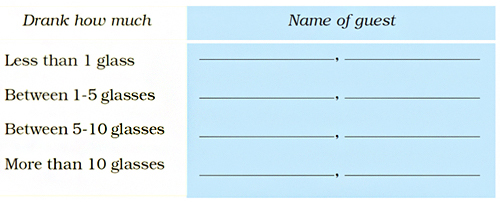
Do it by yourself. Answers may vary. An animal’s capacity for drinking depends on its size. Big animals will drink more glasses and small animals will drink less. A sample answer is:
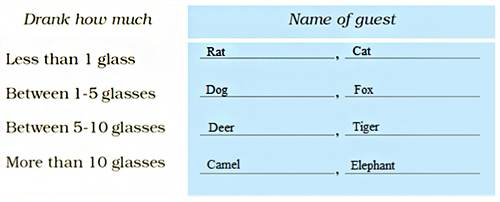
Bottles and Buckets
Make a small drawing if you like.
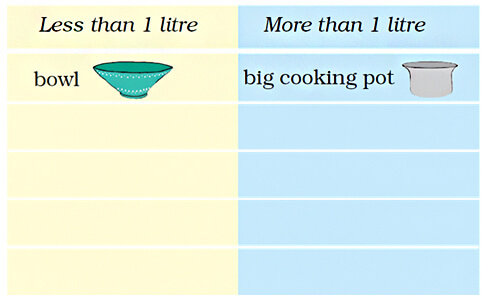
Do it by yourself. Answers may vary. A sample answer is:

Use a 1-litre bottle and check if your guess is right for all the buckets.
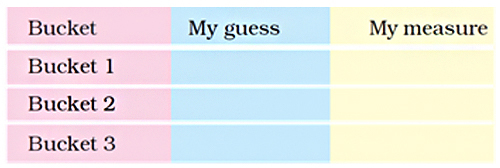
Do it by yourself. Answers may vary. Bucket 1 is the smallest bucket and bucket 2 and bucket 3 are almost the same in height. But bucket 3 is a little wider. A sample answer is:

Match the Right Pairs
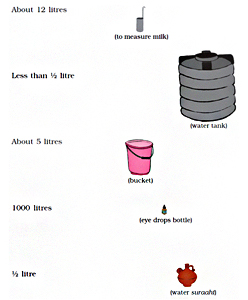
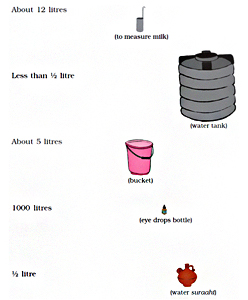
Observe the given things in your surroundings and guess their capacities. The correct answer is:
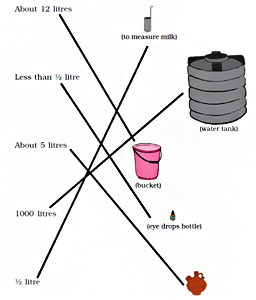
Whose Jug Holds More?
If Najma pours one glass of water in her jug, it looks like this: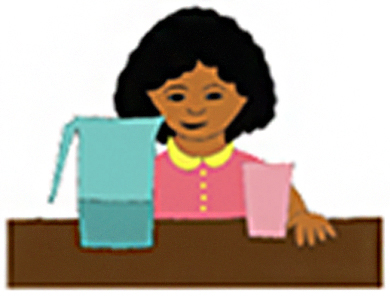
Najma thinks she will have to pour around 3 glasses of water to fill the jug.
- What do you think?
If Jeetu pours one glass of water in his jug, it looks like this: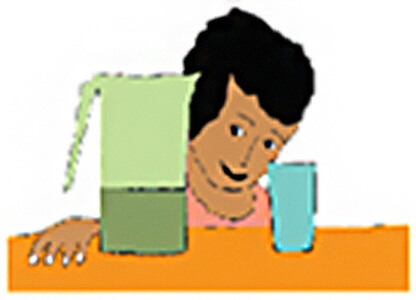
- Whose jug holds more water?
- How many glasses of water do you think Jeetu should pour to fill his jug?
- If Jeetu pours one more glass of water his jug will be around ______ full.
- Naina is correct. It will take 3 glasses to fill the jug.
- Jeetu’s jug holds more water.
- Jeetu should pour about 3 more glasses of water to fill his jug.
- If Jeetu pours one more glass of water, his jug will be around half full.
Filling Pots
Naseem and Abdul had to fill their pots each with water. Both pots were equally big and heavy. So, they went to the tap again and again, filled their own bottles and poured water into the pots.
Naseem had to fill her bottle 16 times from the tap. But Abdul
had to fill his bottle only 8 times.
a)Why did Naseem go more times than Abdul?
b) Naseem's bottle can hold (twice/half/three times) as much water as Abdul's bottle.
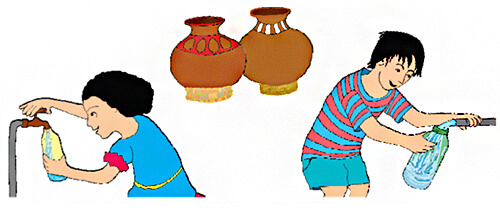
- Naseem is filling her pot with a bottle. Her bottle is smaller than Abdul’s bottle. So, she is taking more time than Abdul to fill the pot.
- Naseem has to go 16 times to the tap to fill her bottles whereas Abdul has to go 8 times to fill his bottle. Since
16 = 2 × 8
Abdul’s bottle can hold twice the water as Naseem’s bottles.
Therefore, Naseem’s bottle can hold half of the water Abdul’s bottle can.
How Many Glasses?
Pot B holds 11 glassfuls of water. Pot A holds twice as much water as pot B. How many glasses of water are needed to fill pot A?
Capacity of Pot A is twice that of Pot B. Since capacity of Pot B is 11 glasses of water, twice the capacity of pot B is:
11 × 2 = 22
Therefore, 22 glasses of water are needed to fill up Pot A.
Filling Potholes
This is a small town near Kohima. There are some potholes in the road. Before the rains come, children want to fill the holes with pebbles. They bring pebbles in mugs of the same size.
Hole A gets filled with 9 mugs of pebbles.
Hole B gets filled with 18 mugs of pebbles.
Hole C gets filled with 12 mugs of pebbles.
- Mark A, B, C on the right hole in the picture.
- Which is the biggest pothole?
- If jugs are used, hole A gets filled with 5 jugs. How many jugs of pebbles are needed to fill hole B?
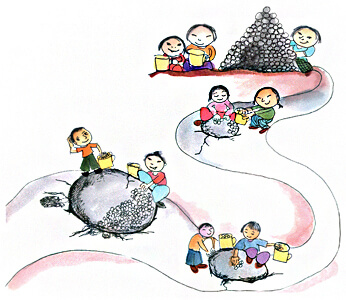
Since hole B gets filled with 18 mugs, C with 12 mugs, and A with 9 mugs of pebbles, mark the biggest path hole with B, the bigger one with C and the smaller one with A.
- B is the biggest pothole.
- 9 mugs fill up hole A and 18 mugs fill up hole B. Since
18 = 2 × 9,
hole B is twice as big as hole A.
Since 5 jugs can fill up the hole A, twice of 5 jugs are needed to fill up hole B.
2 × 5 = 10
Therefore, 10 jugs of pebbles are needed to fill up hole B.
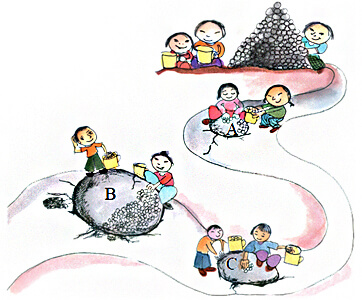
Admissions Open for
Admissions Open for
Frequently Asked Questions
The NCERT solution for Class 3 Chapter 11: Jugs and Mugs is important as it provides a structured approach to learning, ensuring that students develop a strong understanding of foundational concepts early in their academic journey. By mastering these basics, students can build confidence and readiness for tackling more difficult concepts in their further education.
Yes, the NCERT solution for Class 3 Chapter 11: Jugs and Mugs is quite useful for students in preparing for their exams. The solutions are simple, clear, and concise allowing students to understand them better. Jugs and Mugs additionally, they can solve the practice questions and exercises that allow them to get exam-ready in no Jugs and Mugs.
You can get all the NCERT solutions for Class 3 Maths Chapter 11 from the official website of the Orchids International School. These solutions are tailored by subject matter experts and are very easy to understand.
Yes, students must practice all the questions provided in the NCERT solution for Class 3 Maths Chapter 11: Jugs and Mugs as it will help them gain a comprehensive understanding of the concept, identify their weak areas, and strengthen their preparation.
Students can utilize the NCERT solution for Class 3 Maths Chapter 11 by practicing the solutions regularly. Solve the exercises and practice questions given in the solution.
CBSE Schools In Popular Cities
- CBSE Schools in Bangalore
- CBSE Schools in Mumbai
- CBSE Schools in Pune
- CBSE Schools in Hyderabad
- CBSE Schools in Chennai
- CBSE Schools in Gurgaon
- CBSE Schools in Kolkata
- CBSE Schools in Indore
- CBSE Schools in Sonipat
- CBSE Schools in Delhi
- CBSE Schools in Rohtak
- CBSE Schools in Bhopal
- CBSE Schools in Aurangabad
- CBSE Schools in Jabalpur
- CBSE Schools in Jaipur
- CBSE Schools in Jodhpur
- CBSE Schools in Nagpur
- CBSE Schools in Ahmednagar
- CBSE School In Tumkur











